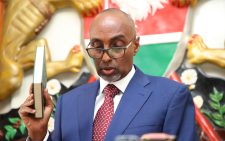Kenya Power survival in doubt as auditor raises more concerns

Auditor General Nancy Gathungu has yet again raised concerns over the survival of Kenya Power.
In a report tabled in the National Assembly, Gathungu regretted that for the eighth year running, the company has remained in a negative working capital position.
Gathungu raised concerns that despite the Board of Directors and Management over the year’s indicating that strategic initiatives were being undertaken to improve the financial results of the Company, these initiatives were yet to yield the intended results as at 30 June.
Further, she noted the situation of the company has been made worse by the fact that the company incurred penalties worth Sh981,803,000 being interest on late payment of invoices which resulted in the increase of cost of sales and negatively affected the company’s cash flows and profitability.
Although the management attributed the delays in settling the invoices to acute shortage of foreign currency in the market, the report says that there was no value for money incurred on the penalties on overdue invoices as it amounted to wastage of resources.
Reads the report: “I draw attention to Note 2(a) to the financial statements which discloses that the Company recorded a negative working capital of Sh27,439,000,000 (2023 Sh51,234,000,000). This indicates the existence of material uncertainty that may cast significant doubt on the company’s ability to continue as a going concern. My opinion is not modified in respect of this matter.”
Gathungu’s report comes hardly days after Kenya Power announced it had recorded profits amounting to Sh30 billion for the full year ending June 2024, recovering from a net loss of Sh3.19 billion in the previous year.
Kenya Power Managing Director and Chief Executive Joseph Siror said that the profits were driven by increased electricity sales and reduced finance costs due to a stronger Kenyan shilling.
The utility firm reported a 21 per cent rise in electricity sales, reaching Sh231.12 billion from Sh190.98 billion, boosted by 447,251 new customer connections and heightened economic activity, especially in the manufacturing sector.
Said Siror: “With revenue in Kenya shillings but most power purchases in foreign currencies, the shilling’s strength in the latter half of the year helped contain sales costs, enhancing gross margins.”
Gathungu in the report has also fingered the institution over a myriad issues including being in possession of pieces of land that have no titles, having unsupported procurement of goods and services, having human resources issues that include payment of acting allowances beyond allowable period and non-compliance with the One-Third Basic Salary Rule as well as having power losses.
Others are penalties on overdue invoices, having high cost of power purchase generated by Independent Powers producers (IPP) as compared to Kengen, weaknesses in electricity consumptions billings, failure to prepare financial statements for a donor Project, delays in completion of customer Electricity Connection Projects as well as weaknesses in electricity consumption billings, power losses as well as instabilities in the power supply network.
On power losses, the report states that a review of units of electricity purchased against units sold revealed a total of 13,684 in gigawatt-hours (GWh) purchased from power producers out of which 10,516 GWh were sold to customers resulting in energy losses of 3,168 GWh or 23.16 per cent.
The report notes that although the Energy and Petroleum Regulatory Authority (EPRA) approved for the Company to recover from consumers system losses of up to 19.5 percent that is deemed to be normal loss the excess of 3.66 percent power loss above the allowed loss constitutes inefficiency power loss which is borne by the Company thus increasing operating costs.
ln addition, the report notes that a review of the power transmission data revealed that the losses occurred in
the distribution and transmission network, but Kenya power did not break down losses arising from those networks which, if accurately determined, can be attributed and borne by respective distribution schemes under the Rural Electrification and Renewable Energy Corporation










